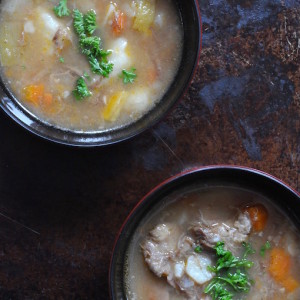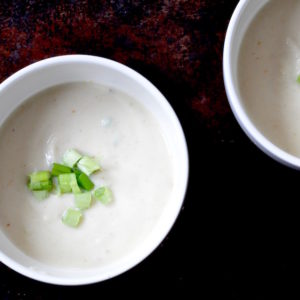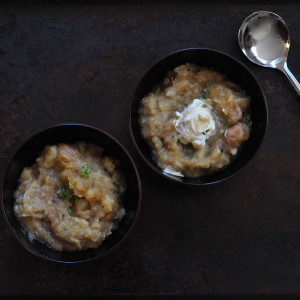Repairing a Ruined Recipe
Today’s post is less about “recipes” than it is about thinking creatively. More succinctly, it is how I turned one awful dish into two good ones, and saved the world.

Well, maybe not that last bit.
I am not the type who recycles leftovers into new dishes. As far as I’m concerned, when it comes to leftovers, it’s strictly reheat and eat. But last week I made this soup, and–spoiler alert–it didn’t turn out well.
Actually, it was inedible.
The soup was a potato-pea with shallots, garlic, carrots, and Coppa. It should’ve been at least decent, but no.
Hours of cooking failed to soften the potatoes. The broth was dully tasteless. The remaining ingredients failed to meld.
And there was a ton of it.
—
Food waste is a popular topic right now. Wherever you look, somebody is earnestly listing the amount of food first world countries throw out or describing their experiences with delivery boxes of bruised vegetables.
We get it. Food waste is a bad thing.
Food waste is also impossible to avoid if you cook seriously. Who among us hasn’t forgotten that last little bit in the tupperware, only to find it moldering in the fridge six months later?
Who among us hasn’t prepared an elaborate recipe only to find it inedible?
Sometimes a bad dish may be remedied by addition: salt, some sort of hot pepper, cream, an acid like vinegar or lemon. Not this time. No amount of addition would coax this soup into edibility.
Instead, I took it apart.
First, I dumped the whole mess into a colander, which I’d set over a bowl. My plan was to catch the chicken broth, but the potatoes had absorbed most of it.
I then rinsed everything in cool water, and separated the potatoes from the peas, dividing the carrots evenly between each.
I had just over a pound (700 grams) of potatoes.
Lavishly buttering a clay baking dish….

I layered the potato slices in it….
 scattering a few carrot slices here and there.
scattering a few carrot slices here and there.

I went easy on the salt, as the potatoes were already seasoned, poured in heavy cream, and slid it into a cold oven, which I turned to 350F/180C.

Why a cold oven? The baking dish would have shattered otherwise.
After about 25 minutes, the potato gratin was bubbling, browned, and beautiful. I added some panko, gave it a few more minutes, and viola:

Turning to the peas…
I had in mind a sort of fritter/pancake type of thing. To this end, I added a half-teaspoon of baking powder, a scant four tablespoons flour (60 grams, for your metric fans), and an egg white. The egg white wasn’t necessary, but hey, live and learn.

The pea fritters were fragile, but held together just enough for me use a cast iron griddle, acquired at the Alameda County Antique Faire.

The griddle, holding a bitter melon.
Frankly, the fritters weren’t as successful as the gratin. They weren’t bad, just rather bland.

If you take nothing else from this post, do know that experienced cooks mess up royally. And that some errors may be fixed, if time permits.
Also that, occasionally, you might need to throw something out. Life happens.
While you can prepare the recipes below from scratch, do know I made them from ingredients salvaged from a failed soup. As a result, they aren’t as precise as usual.
For the potato gratin:
butter, for the baking dish
A generous 1 pound/700 grams waxy potatoes, either scrubbed or peeled and sliced thinly
1 small carrot, either scrubbed or peeled and thinly sliced into coins
1-2 garlic cloves, peeled and thinly sliced
enough heavy cream, milk, or half-and-half to cover the potatoes
salt and pepper
panko or bread crumbs
If your potatoes are raw, parboil or microwave them until just tender: you should be able to break one in half with a fork.
Preheat the oven to 350F/180C. Note that I used a clay baking dish to make my gratin, so instead of preheating the oven, I started the gratin cold. This way, the dish would not shatter.
Butter a baking dish lavishly. Arrange the potato slices in a single layer, adding the carrot and garlic. Season with salt and pepper.
Place the baking dish on a baking sheet, then pour enough cream into the baking dish to just cover the potatoes. You don’t want them swamped; see photo, above.
Carefully place the baking sheet/gratin dish in the oven and bake; about ten minutes before the gratin is done, add panko or bread crumbs on top, if desired. Total baking time is 30-45 minutes, depending on size of dish.
Potato gratin may be served as a side dish, but it’s so rich we eat it as a main with green salad. Gratin will keep, covered and refrigerated, up to four days. While you can freeze a potato gratin, its texture will suffer.
For the pea fritters:
Pea Fritters
Yield: about ten fritters from a 10 ounce/280 gram bag of frozen peas; bear in mind I made these after draining the peas from soup.
One 10 ounce/280 gram bag frozen peas, preferably organic
enough AP flour to bind; I needed about 4 tablespoons/60 grams
1/2 teaspoon baking powder
salt and pepper, to taste
1 scallion, minced (optional)
1 garlic clove, peeled and minced (optional)
sunflower or grapseed oil, for frying
Mix peas, flour, salt, pepper, scallion, and garlic clove in medium bowl. You want the ingredients to bind just enough to form fritters. You may need more flour.
I made palm-sized fritters.
Heat a cast-iron griddle or cast-iron frying pan over medium high heat. Add a small amount of sunflower or grapeseed oil. Fry as many fritters as fit comfortably in pan; do not crowd. Mine needed about three minutes per side. When fritters are done cooking, transfer to waiting plate or platter. Pea fritters be kept in low oven for an hour or so.
Serve pea fritters as appetizer or side dish. May be refrigerated up to three days in covered container. Freezing not recommended.





